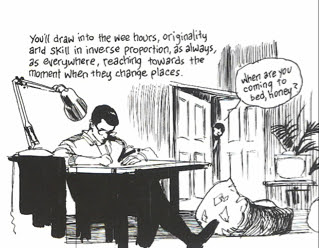This is an intriguing panel, because it dares you to use the text itself to analyse both the art and the scene depicted. Here, Campbell's narration over the scene notes that "You'll draw into the wee hours, originality and skill in inverse proportion, as always, as everywhere, reaching towards the moment when they change places."
Within the scene, Campbell is working under a swing arm desk light as his wife calls him to bed. There's no clear indication if his wife is on her way to bed, or has woken from sleep and journeyed to find her elusive husband. The light cast by the lamp fills the panel; stationed to the left, and in a perspective which places it closest to the reader, we're reading the art left to right and thus following the light into both the room and the scene. The contrast between black and white is sharpest at this entry point into the panel, the white of the page itself bleeding into the panel, while the blackness of Campbell's legs and the chest of drawers upon which the lamp sits are crafted from broad brush-strokes of thick black ink.
This entry point into the panel is fresh from the page, there being no panel borders. The art is demanding attention, demanding to be treated as a work of art rather than as a panel; this panel is something of itself, and not just here to make up the numbers in some grand tapestry or patchwork quilt. Perhaps this is in some small part something of the struggle Campbell alludes to; that as each moment in life is a moment in and of itself, so each panel on a page is a piece of art too.
As Campbell's art draws you across the panel, your attention is captured by his wife, Annie, calling Campbell to bed from the door. It's hard not to look at this piece of the panel and wonder if the narrative text doesn't reference it too; is there a sub-text here on other areas of life where one also strives for originality and skill and the moments when they match?
Campbell's art in this one panel, to my mind, is to capture everything that has inspired him. In his first Comics Journal interview, in issue 145, Campbell is quoted as stating that through his work he is
not trying to make ordinary life interesting: it is interesting.
Here Campbell marries style to observation in a manner which suggests to this reader he has achieved the perfect balance between originality and skill. The setting, with the working artist juxtaposed against the wider world, his artistic space intruded upon or intruding itself against the pot-plants and bean bags of life, speaks of the artistic struggle the narration contends. And with the man himself too big for the frame, foot stretched out beyond the room and into the page, he anchors himself within a moment that passes too quickly with both the ink on the page and the remembered or imagined words of his wife.
This panel appears in my copy of alec how to be an artist on page 66. Campbell adds a reply to, or a continuation of this panel on the bottom of page 67, which, played for laughs, suggests a sub-text or two can happily be read.
Campbell's much lamented blog can be found at http://eddiecampbell.blogspot.com/
how to be an artist has been subsumed into the must have book, Alec: The Years Have Pants











0 comments:
Post a Comment